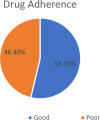Incidence and predictors of seizure-related injuries among epileptic patients undergoing follow-up treatment at public hospitals in Central Ethiopia
- PMID: 39890819
- PMCID: PMC11785985
- DOI: 10.1038/s41598-025-86268-5
Incidence and predictors of seizure-related injuries among epileptic patients undergoing follow-up treatment at public hospitals in Central Ethiopia
Abstract
Seizure-related injuries represent a significant concern for both individuals with epilepsy and their caregivers. Compared to the general population, those diagnosed with epilepsy face a heightened risk of sustaining injuries. Despite this, there is a notable scarcity of data regarding seizure-related injuries among epileptic patients. This study aimed to evaluate the incidence of seizure-related injuries and identify their predictors among epileptic patients undergoing follow-up treatment at selected public hospitals in Central Ethiopia, in 2023. A prospective follow-up study was carried out in selected public hospitals in central Ethiopia. The study included epileptic patients aged ≥ 18 years who had not experienced any previous injury during follow-up treatment from January 1st, 2023, to December 31st, 2023. Data collection involved conducting interviews with participants using a structured questionnaire and reviewing patients' charts. Univariate analysis, multivariate, and regression analysis were performed to identify potential associations between variables and seizure-related injuries. Variables were deemed significantly associated with seizure-related injuries if they attained a p value of 0.05 with a 95% confidence interval. Out of the 561 participants, 265 (47.2%) experienced seizure-related injuries (95% CI 43.12, 51.38). The incidence density rate of seizure-related injuries among epileptic patients was 11.97 per 100 person-months of observation (95% CI 10.61, 13.50). In multivariate analysis, epileptic patients who had generalized tonic-clonic seizures (adjusted hazard ratio 1.4, 95% CI 1.07-1.84), comorbidities (adjusted hazard ratio 1.3, 95% CI 1.11-1.71), were on polytherapy drug regimens (adjusted hazard ratio 1.80, 95% CI 0.30-2.49), and consumed alcoholic drinks (adjusted hazard ratio 1.5, 95% CI 1.21-1.89) were identified as independent predictors of seizure-related injuries. The incidence rate of seizure-related injuries among epileptic patients was found to be significant. Risk factors identified included experiencing generalized tonic-clonic seizures, having at least one additional health condition, being on multiple medications, and consuming alcohol. To improve survival from injuries, targeted precautions for generalized tonic-clonic seizures, strict adherence to prescribed medication regimens, and avoiding alcohol consumption are recommended.
Keywords: Epileptic; Ethiopia; Predictors; Seizure; Seizure-related injury.
© 2025. The Author(s).
Conflict of interest statement
Declarations. Competing interests: The authors declare no competing interests. Ethical approval and consent to participate: Ethical consideration was obtained from the institutional review board of Wachemo University (protocol number = wcu-IRB 029/22). The Institutional Review Board (IRB) of Wachemo University, College of Medicine and Health Sciences provided the ethical letter and the medical directors of the hospitals where the data was collected provided written approval. Following an explanation of the study’s purpose, potential benefits, and the estimated time required to complete the interview, oral and written informed consent was obtained from each participating epileptic patient before proceeding with the procedure. Every single piece of information taken from the medical records was kept private and utilized just for this purpose. All methods were performed in accordance with the relevant guidelines and regulations’ in the manuscript. Consent for publication: Not applicable.
Figures






Similar articles
-
Idiopathic (Genetic) Generalized Epilepsy.2024 Feb 12. In: StatPearls [Internet]. Treasure Island (FL): StatPearls Publishing; 2025 Jan–. 2024 Feb 12. In: StatPearls [Internet]. Treasure Island (FL): StatPearls Publishing; 2025 Jan–. PMID: 31536218 Free Books & Documents.
-
Lamotrigine versus carbamazepine monotherapy for epilepsy: an individual participant data review.Cochrane Database Syst Rev. 2018 Jun 28;6(6):CD001031. doi: 10.1002/14651858.CD001031.pub4. Cochrane Database Syst Rev. 2018. PMID: 29952431 Free PMC article.
-
Prognosis of adults and children following a first unprovoked seizure.Cochrane Database Syst Rev. 2023 Jan 23;1(1):CD013847. doi: 10.1002/14651858.CD013847.pub2. Cochrane Database Syst Rev. 2023. PMID: 36688481 Free PMC article.
-
Lamotrigine versus carbamazepine monotherapy for epilepsy: an individual participant data review.Cochrane Database Syst Rev. 2016 Nov 14;11(11):CD001031. doi: 10.1002/14651858.CD001031.pub3. Cochrane Database Syst Rev. 2016. Update in: Cochrane Database Syst Rev. 2018 Jun 28;6:CD001031. doi: 10.1002/14651858.CD001031.pub4. PMID: 27841445 Free PMC article. Updated.
-
Treatments for seizures in catamenial (menstrual-related) epilepsy.Cochrane Database Syst Rev. 2021 Sep 16;9(9):CD013225. doi: 10.1002/14651858.CD013225.pub3. Cochrane Database Syst Rev. 2021. PMID: 34528245 Free PMC article.
References
-
- Fisher, R. S. et al. Epileptic seizures and epilepsy: Definitions proposed by the International League Against Epilepsy (ILAE) and the International Bureau for Epilepsy (IBE). Epilepsia46(4), 470–472 (2005). - PubMed
-
- Falco-Walter, J. J., Scheffer, I. E. & Fisher, R. S. The new definition and classification of seizures and epilepsy. Epilepsy Res.139, 73–79 (2018). - PubMed
-
- Fisher, R. S. et al. ILAE official report: A practical clinical definition of epilepsy. Epilepsia55(4), 475–482 (2014). - PubMed
-
- World Health Organization, W. Epilepsy 9 February 2023; Available from: https://www.who.int/news-room/fact-sheets/detail/epilepsy.
Publication types
MeSH terms
LinkOut - more resources
Full Text Sources
Medical

